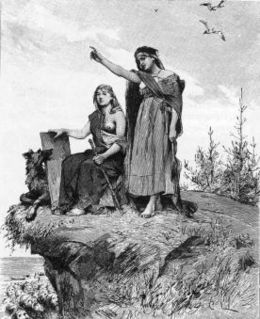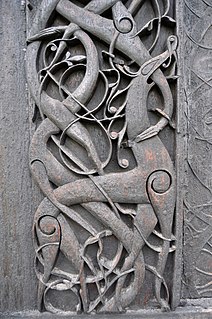
In Norse mythology, Ask and Embla —male and female respectively—were the first two humans, created by the gods. The pair are attested in both the Poetic Edda, compiled in the 13th century from earlier traditional sources, and the Prose Edda, written in the 13th century by Snorri Sturluson. In both sources, three gods, one of whom is Odin, find Ask and Embla and bestow upon them various corporeal and spiritual gifts. A number of theories have been proposed to explain the two figures, and there are occasional references to them in popular culture.
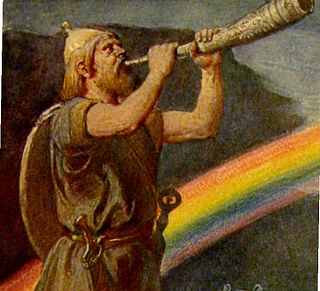
In Norse mythology, Bifröst is a burning rainbow bridge that reaches between Midgard (Earth) and Asgard, the realm of the gods. The bridge is attested as Bilröst in the Poetic Edda; compiled in the 13th century from earlier traditional sources, and as Bifröst in the Prose Edda; written in the 13th century by Snorri Sturluson, and in the poetry of skalds. Both the Poetic Edda and the Prose Edda alternately refer to the bridge as Ásbrú.

In Norse mythology, the Nine Mothers of Heimdallr are nine sisters who gave birth to the god Heimdallr. The Nine Mothers of Heimdallr are attested in the Prose Edda, written in the 13th century by Snorri Sturluson; in the poetry of skalds; and possibly also in a poem in the Poetic Edda, a book of poetry compiled in the 13th century from earlier traditional material. Scholars have debated what being "born of nine mothers" implies and have sought to connect the notion to other European folk motifs. Scholars have theorized that Heimdallr's Nine Mothers may be identical to the Nine Daughters of Ægir and Rán, who personify waves. In turn, Heimdallr would be born of the sea.

In Norse mythology, Garmr or Garm is a wolf or dog associated with both Hel and Ragnarök, and described as a blood-stained guardian of Hel's gate.

In Norse mythology, Gullveig is a being who was speared by the Æsir, burnt three times, and yet thrice reborn. Upon her third rebirth, Gullveig's name becomes Heiðr and she is described as a knowledgeable and skillful völva. Gullveig/Heiðr is solely attested in the Poetic Edda, compiled in the 13th century from earlier traditional material. Scholars have variously proposed that Gullveig/Heiðr is the same figure as the goddess Freyja, that Gullveig's death may have been connected to corruption by way of gold among the Æsir, and/or that Gullveig's treatment by the Æsir may have led to the Æsir–Vanir War.
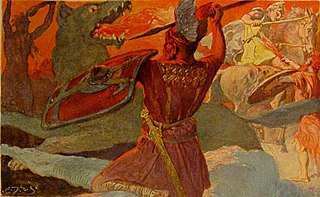
In Norse mythology, Vígríðr or Óskópnir is a large field foretold to host a battle between the forces of the gods and the forces of Surtr as part of the events of Ragnarök. The field is attested in the Poetic Edda, compiled in the 13th century from earlier traditional material, and in the Prose Edda, written by Snorri Sturluson in the 13th century. The Poetic Edda briefly mentions the field as where the two forces will battle, whereas the Prose Edda features a fuller account, foretelling that it is the location of the future death of several deities before the world is engulfed in flames and reborn.

In Norse mythology, Ýdalir ("yew-dales") is a location containing a dwelling owned by the god Ullr. Ýdalir is solely attested in the Poetic Edda, compiled in the 13th century from earlier traditional sources. Scholarly theories have been proposed about the implications of the location.

In Norse mythology, Surtr is a jötunn. Surtr is attested in the Poetic Edda, compiled in the 13th century from earlier traditional sources, and the Prose Edda, written in the 13th century by Snorri Sturluson. In both sources, Surtr is foretold as being a major figure during the events of Ragnarök; carrying his bright sword, he will go to battle against the Æsir, he will do battle with the major god Freyr, and afterward the flames that he brings forth will engulf the Earth.

Máni is the personification of the moon in Norse mythology. Máni, personified, is attested in the Poetic Edda, compiled in the 13th century from earlier traditional sources, and the Prose Edda, written in the 13th century by Snorri Sturluson. Both sources state that he is the brother of the personified sun, Sól, and the son of Mundilfari, while the Prose Edda adds that he is followed by the children Hjúki and Bil through the heavens. As a proper noun, Máni appears throughout Old Norse literature. Scholars have proposed theories about Máni's potential connection to the Northern European notion of the Man in the Moon, and a potentially otherwise unattested story regarding Máni through skaldic kennings.

Norse cosmology is the study of the cosmos (cosmology) as perceived by the North Germanic peoples. The topic encompasses concepts from Norse mythology, such as notions of time and space, cosmogony, personifications, anthropogeny, and eschatology. Like other aspects of Norse mythology, these concepts are primarily recorded in the Poetic Edda, a collection of poems compiled in the 13th century, and the Prose Edda, authored by Icelander Snorri Sturluson in the 13th century, who drew from earlier traditional sources. Together these sources depict an image of Nine Worlds around a cosmic tree, Yggdrasil.

Sól or Sunna is the Sun personified in Norse mythology. One of the two Old High German Merseburg Incantations, written in the 9th or 10th century CE, attests that Sunna is the sister of Sinthgunt. In Norse mythology, Sól is attested in the Poetic Edda, compiled in the 13th century from earlier traditional sources, and the Prose Edda, written in the 13th century by Snorri Sturluson.
In Norse mythology, Gnipahellir is a mythical cave. Gnipahellir is the home of Garmr, the hellhound who guards the gates of Hel, the Norse realm of the dead. Garmr is often featured chained here until the onset of Ragnarök, at which time his bindings break and he runs free. Reference to Gnipahellir appears in Vǫluspá, Prophecy of the Völva, one of the poems of the Poetic Edda.
Niðafjöll, which means dark mountains, are located in the northern underworld. Niðafjöll is the site from which the dragon Níðhöggr comes. According to Snorri Sturluson, the good and virtuous people will live here in a golden palace after the Ragnarök, despite its proximity to Hel.
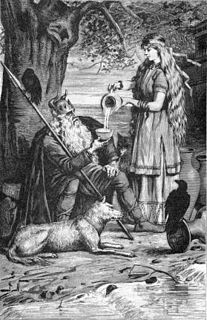
In Norse mythology, Sága is a goddess associated with the wisdom Sökkvabekkr. At Sökkvabekkr, Sága and the god Odin merrily drink as cool waves flow. Both Sága and Sökkvabekkr are attested in the Poetic Edda, compiled in the 13th century from earlier traditional sources, and in the Prose Edda, written in the 13th century by Snorri Sturluson. Scholars have proposed theories about the implications of the goddess and her associated location, including that the location may be connected to the goddess Frigg's fen residence Fensalir and that Sága may be another name for Frigg.

In Norse mythology, the Kerlaugar i.e. "bath-tub", are two rivers through which the god Thor wades. The Kerlaugar are attested in the Poetic Edda, compiled in the 13th century from earlier traditional material, and in a citation of the same verse in the Prose Edda, written in the 13th century by Snorri Sturluson.



